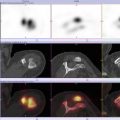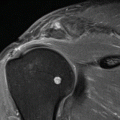© Springer-Verlag Berlin Heidelberg 2015
Andor W.J.M. Glaudemans, Rudi A.J.O. Dierckx, Jan L.M.A. Gielen and Johannes (Hans) Zwerver (eds.)Nuclear Medicine and Radiologic Imaging in Sports Injuries10.1007/978-3-662-46491-5_2222. Injuries of Wrist, Hand and Fingers
(1)
Department of Rehabilitation Medicine, University Medical Center Groningen, 30.001, 9700 RB Groningen, The Netherlands
22.2 Functional Anatomy
22.3.1 Distal Radius Fractures
22.3.2 Scaphoid Fractures
22.3.4 Hook of Hamate Fractures
22.3.5 Pisiform Fractures
22.3.6 Triquetrum Fractures
22.3.7 Capitate Fractures
22.4.1 Scapholunate Dissociation
22.4.4 Carpal Dislocation
22.5.1 De Quervain’s Syndrome
22.5.2 Intersection Syndrome
22.6 Injuries of the Hand
22.6.1 Fractures
22.6.2 PIP Joint Injuries
22.6.6 Pulley Lesions
22.7 Conclusions
Abstract
Sports injuries of the hand and wrist are common. Wrist injuries occur mostly due to a fall on the outstretched hand. Distal radius fractures and scaphoid fractures are the most frequently seen fractures of the wrist. Ligament injuries of the wrist may not always be that obvious at first sight, but may lead to serious secondary consequences, such as carpal collapse and osteoarthritis. Next to acute injuries, overuse injuries are also frequently encountered. Overuse injuries mainly affect tendons and nerves, such as in M. de Quervain, the intersection syndrome, carpal tunnel syndrome or the cyclist’s wrist.
Injuries to the hand comprise fractures, dislocations, contusions, sprains and overuse injuries. In this chapter, fractures such as the boxer’s fracture, PIP joint injuries, injuries to the thumb such as the skier’s thumb and pulley injuries are described. A thorough evaluation of the injury mechanism and a systematic clinical examination are the keys to successful treatment and return to sporting activities.
Abbreviations
APL
Abductor pollicis longus
CMCJ
Carpometacarpal joint
DIPJ
Distal interphalangeal joint
DISI
Distal intercalated segment instability
DRUJ
Distal radioulnar joint
ECRB
Extensor carpi radialis brevis
ECRL
Extensor carpi radialis longus
ECU
Extensor carpi ulnaris
EPB
Extensor pollicis brevis
EPL
Extensor pollicis longus
FCR
Flexor carpi radialis
FCU
Flexor carpi ulnaris
FDP
Flexor digitorum profundus
FDS
Flexor digitorum superficialis
FPL
Flexor pollicis longus
IPJ
Interphalangeal joint
MCPJ
Metacarpophalangeal joint
PIPJ
Proximal interphalangeal joint
PL
Palmaris longus
PQ
Pronator quadratus
PT
Pronator teres
TFCC
Triangular fibrocartilaginous complex
UCL
Ulnar collateral ligament
22.1 Introduction and Epidemiology
Hand and wrist injuries in sports are frequently reported. Three to 9 % of all athletic injuries involve the hand and wrist (Rettig 2003). Sytema et al. analysed over 25,000 sports injury cases attending at an emergency department and found that the upper extremity holds a substantial part (35 %) in sports injuries (Sytema et al. 2010). Furthermore, they revealed that nearly 70 % of upper limb injuries occurred to the hand or wrist (Sytema et al. 2010). Most upper extremity injuries are caused by a fall or by getting struck by a ball. Sports with a high risk on sustaining upper extremity injuries due to falling are horse riding, speed skating, (inline) skating, skiing, snowboarding and school sports. Ball sports cause less upper limb than lower limb injuries, but the number of hand injuries due to getting struck by a ball is still substantial (17 % of all upper limb sports injuries). Compared to lower extremity, the upper extremity contains a very high fracture rate, especially in adolescents and children (Sytema et al. 2010; Conn et al. 2003; Cuddihy and Hurley 1990; Court-Brown et al. 2008; Flood and Mina 1985; Wood et al. 2010). Fractures, sprains and contusions most frequently occur, followed by wounds and dislocations (Sytema et al. 2010). Forty percent of all sports-related upper limb fractures are located in carpus, metacarpus or fingers (Court-Brown et al. 2008). Males are more affected than females (Sytema et al. 2010; Wood et al. 2010). Although nearly 90 % of the world population is right-handed, this is not reflected in the side of the athletes’ injured upper extremity, since there is an equal distribution of left- and right-sided injuries (Sytema et al. 2010). Many injuries are sports specific, such as Guyon’s canal syndrome in cyclists, the intersection syndrome in rowers, fractures of the hook of the hamate in golf, tennis or baseball or distal physeal injuries in gymnasts.
22.2 Functional Anatomy
22.2.1 Anatomy of Hand and Wrist (ASSH 2001)
Bones, Joints and Ligaments
The skeleton of the hand and wrist consists of 27 bones. These bones are located in the carpus, metacarpus and phalanges. From the radial to the ulnar side, the carpus consists of a proximal row of four bones (scaphoid, lunate, triquetrum and pisiform) and a distal row of four bones (trapezium, trapezoid, capitate and hamate). The metacarpus consists of five bones, and the thumb contains two phalanges, whereas the remaining fingers consist of three phalanges.
The stability of the wrist is provided by ligaments connecting radius, ulna and carpus. The most important wrist stabilisers at the radial side are the scapholunate ligament, the radioscaphocapitate ligament and the radioscapholunate ligaments. The TFCC combined with the ulnolunate ligament and the ulnar collateral ligament stabilise the ulnar side of the wrist. The stability of the metacarpophalangeal (MCP) joint and the interphalangeal (IP) joints is provided by collateral ligaments and, on the volar side, by fibrocartilaginous volar plates.
Muscles
The muscles of hand and wrist can be divided into extrinsic and intrinsic muscles. The extrinsic muscles have their origins outside the hand and their insertions within the hand, whereas the intrinsic muscles have their origins and insertions within the hand. The tendons of the extrinsic extensors are arranged in six tendon compartments over the dorsum of the wrist. The flexor tendons enter the hand at the carpal tunnel. At the level of the MCP joint and more distally, the flexors lie anterior to the volar plates and are surrounded by the flexor tendon sheath. The flexor tendon sheath is thickened by annular and cruciate fibres, the so-called pulleys, which act as stabilisers for the flexor tendons. The pulleys also facilitate tendon excursion and provide for nutrition. The intrinsic muscles consist of the thenar and hypothenar groups and the lumbrical and interosseous muscles.
Nerves
The hand is innervated by the radial, median and ulnar nerves.
The radial nerve is innervating the muscles that extend the wrist and MCP joints and that abduct and extend the thumb. The sensory branches innervate the dorsum of the hand and thumb, except for the ulnar side of the hand. The posterior interosseous nerve innervates the dorsal wrist capsule.
The median nerve innervates part of the flexors of the wrist (pronator teres (PT), pronator quadratus (PQ), m. flexor carpi radialis (FCR), m. palmaris longus (PL), m. flexor pollicis longus (FPL), m. flexor digitorum superficialis (FDS) and the radial part of the m. flexor digitorum profundus (FDP)). The median nerve enters the hand through the carpal tunnel. The motor branch innervates various muscles of the thenar and the lumbrical muscles of the second and third ray. The sensory branches of the median nerve innervate the volar side of the palm, thumb, index finger, long finger and radial side of the ring finger. The anterior interosseous nerve is a branch of the median nerve and innervates the volar wrist capsule.
The ulnar nerve innervates the remaining flexors of the hand and wrist (m. flexor carpi ulnaris (FCU)) and the ulnar part of the FDP. The ulnar nerve accompanies the ulnar artery when entering the wrist through Guyon’s canal. This tunnel is located radial to the pisiform bone and ulnar to the hook of the hamate. The ulnar nerve also innervates the thenar muscles, the ulnar part of the lumbrical muscles, the interosseous muscles and the adductor muscle of the thumb. Distal from Guyon’s canal, the sensory branches innervate the volar and dorsal sides of the small finger and the ulnar part of the ring finger.
Vessels
The blood supply of the hand is provided by the radial and ulnar arteries through an arterial arch system.
22.2.2 Clinical Examination of Hand and Wrist (ASSH 2001)
Clinical examination of the hand and wrist starts with exposure of the entire upper extremity. The active and passive shoulder and elbow motion should be examined. These proximal joints are essential in positioning of the hand. Always compare the affected hand with the contralateral side.
Further physical examination of the hand and wrist consists of inspection, the active and passive range of joint motion, muscle testing, palpation, evaluation of the cutaneous sensibility and evaluation of the arterial circulation.
Inspection
When inspecting the hand, one should observe abnormal posture or position, colour, skin moisture, swelling and oedema, scars, skin lesions, abnormalities of the nails and muscle atrophy.
Active and Passive Range of Joint Motion
The active range of motion of the wrist, thumb and fingers should be measured using a goniometer. The usual way to note joint mobility is extension-neutral-flexion and radial deviation-neutral-ulnar deviation. Wrist movements are flexion, extension, ulnar and radial deviation, pronation and supination. Flexion and extension as well as radial and ulnar deviation result from radiocarpal and intercarpal motion. Pronation and supination occur through the proximal and distal radioulnar joints. The MCP movements are flexion, (hyper)extension, abduction and adduction. The thumb movements are flexion and (hyper)extension, abduction and adduction and opposition or combinations of these movements. IP movements are flexion and (hyper)extension.
Muscle Testing
Extrinsic as well as intrinsic muscles should be systematically evaluated; its strength should be graded and recorded.
Palpation
Most tendons of hand and wrist are palpable, especially when they are examined against resistance. The bones and joints of the hand are easy to palpate. Palpation of the wrist is somewhat more complicated, although the styloid processes of the ulna and the radius are easy to palpate on the lateral aspects of the wrist. Lister’s tubercle, also called tuberculum dorsale, is the most apparent dorsal prominence of the radius. The lunate is located just distally from Lister’s tubercle, and the capitate is positioned proximally from the lunate. The scaphoid is palpable on the floor of the anatomic snuff box, which is formed by the tendons of the m. extensor pollicis longus (EPL, ulnar side) and the m. abductor pollicis longus (APL) and m. extensor pollicis brevis (EPB, radial side).
Neurological Evaluation: Cutaneous Sensibility
Sensibility can be evaluated by static and moving two-point touch discrimination or the Semmes-Weinstein Aesthesiometer monofilament testing (SWMT) set (Jerosch-Herold 2003; Bell-Krotoski et al. 1993). The SWMT testing set includes 20 monofilaments of different thicknesses. When a monofilament buckles on the skin, a predefined force is applied. The starting filament is the 2.83 filament, which reflects normal sensibility. If that filament is sensed, a thinner filament is tested, and if not, a thicker filament is tested. Low cutaneous sensibility is related to the thicker monofilaments of the SMWT testing set.
Circulation
The circulation of the hand is evaluated by examining the colour of the skin and nails and testing the capillary refill. To test the patency of the radial and ulnar arteries, the Allen test can be performed: The examiner occludes the radial artery for several minutes and compares the hand colour to the other hand. If there is sufficient collateral circulation through the ulnar artery, no change in colour should be observed. The procedure can be repeated by occluding the ulnar artery.
22.3 Bone Injuries of the Wrist
22.3.1 Distal Radius Fractures
Distal radius fractures are common sports injuries (Court-Brown et al. 2008; Chen et al. 2009). The mechanism of injury is mostly a fall on the outstretched hand, which might be sustained during hockey, soccer, gymnastics, snowboarding, badminton, ice-skating or in-line skating (Court-Brown et al. 2008; Chen et al. 2009). There are various types of distal radius fractures, which need different therapeutical approaches. Physical examination reveals swelling of the wrist, possible deformities, pain and tenderness at the distal part of the radius and restricted range of motion. Distal radius fractures may be accompanied by other injuries, such as carpal fractures, ligament injuries of the carpus or of the distal radioulnar joint or injuries at the elbow region.
Stay updated, free articles. Join our Telegram channel

Full access? Get Clinical Tree







